|
|
|
The Bar-Kays Bio
Home
| Discography | Where
Are They Now?
Larry Dodson '96 Interview | Harvey
Henderson '96 Interview
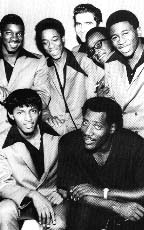 The Bar-Kays were
formed in Memphis, Tennessee sometime in the mid-sixties and originally consisted of James
Alexander (bass), Ronnie Caldwell (organ), Ben Cauley
(trumpet), Phalon Jones (sax), Carl Cunningham (drums)
and Jimmy King (guitar). In early '67, they were signed to Volt, a Stax
subsidiary. Al Jackson, the drummer with Booker T & the MGs, took a special interest
in the Bar-Kays from the start and groomed them into a funky, instrumental R&B combo
in the Mar-Keys' mold. Soon thereafter, the Bar-Kays became Stax' second house band,
supporting Sam & Dave, Otis Redding and many other of the label's premier artists. The
Bar-Kays' first single in their own right, "Soul Finger,"
became a huge hit on both the R&B and pop charts in the spring of '67 and an album
with the same title was issued as well. That summer, Otis Redding chose the Bar-Kays to be
his regular backing band and it was on route to a gig on December 10, 1967 that tragedy
struck. The plane, carrying Otis and the Bar-Kays, crashed into the frozen lake Monono,
near Madison, Wisconsin. Everyone on board was killed except trumpeter Ben Cauley, who
miraculously survived and bassist James Alexander, who had not been on the plane. The Bar-Kays were
formed in Memphis, Tennessee sometime in the mid-sixties and originally consisted of James
Alexander (bass), Ronnie Caldwell (organ), Ben Cauley
(trumpet), Phalon Jones (sax), Carl Cunningham (drums)
and Jimmy King (guitar). In early '67, they were signed to Volt, a Stax
subsidiary. Al Jackson, the drummer with Booker T & the MGs, took a special interest
in the Bar-Kays from the start and groomed them into a funky, instrumental R&B combo
in the Mar-Keys' mold. Soon thereafter, the Bar-Kays became Stax' second house band,
supporting Sam & Dave, Otis Redding and many other of the label's premier artists. The
Bar-Kays' first single in their own right, "Soul Finger,"
became a huge hit on both the R&B and pop charts in the spring of '67 and an album
with the same title was issued as well. That summer, Otis Redding chose the Bar-Kays to be
his regular backing band and it was on route to a gig on December 10, 1967 that tragedy
struck. The plane, carrying Otis and the Bar-Kays, crashed into the frozen lake Monono,
near Madison, Wisconsin. Everyone on board was killed except trumpeter Ben Cauley, who
miraculously survived and bassist James Alexander, who had not been on the plane.
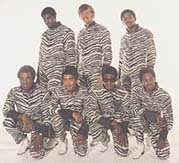 In
1968, James Alexander and Ben Cauley, together with Allen Jones
(the Stax writer and producer who would continue to work with the Bar-Kays
until his untimely death in the late eighties) reformed the group and
recruited Harvey Henderson (sax), Ronnie Gordon
(keyboards), Michael Toles (guitar) and drummers
Willie Hall and Roy Cunningham. Once again,
the Bar-Kays, particularly the rhythm section but also the horns, served
as Stax' house band and backed countless artists, such as Rufus Thomas,
Albert King and The Staple Singers. The solid, bluesy funk rhythms on
Isaac Hayes' ground-breaking, platinum selling LP "Hot Buttered
Soul" were supplied by the Bar-Kays too. Although their own singles
and the "Gotta Groove" LP, issued in 1969,
sounded much like a continuation from where the first edition of the
band had left off, the post-crash Bar-Kays seemed unable to come up
with a major hit a la "Soul Finger." In
1968, James Alexander and Ben Cauley, together with Allen Jones
(the Stax writer and producer who would continue to work with the Bar-Kays
until his untimely death in the late eighties) reformed the group and
recruited Harvey Henderson (sax), Ronnie Gordon
(keyboards), Michael Toles (guitar) and drummers
Willie Hall and Roy Cunningham. Once again,
the Bar-Kays, particularly the rhythm section but also the horns, served
as Stax' house band and backed countless artists, such as Rufus Thomas,
Albert King and The Staple Singers. The solid, bluesy funk rhythms on
Isaac Hayes' ground-breaking, platinum selling LP "Hot Buttered
Soul" were supplied by the Bar-Kays too. Although their own singles
and the "Gotta Groove" LP, issued in 1969,
sounded much like a continuation from where the first edition of the
band had left off, the post-crash Bar-Kays seemed unable to come up
with a major hit a la "Soul Finger."
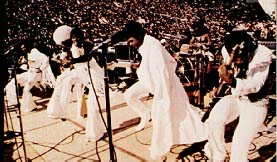 By 1970 drummer Roy
Cunningham had left the band and so had keyboardist Ronnie Gordon. The latter was replaced
by Winston Stewart. Under the guidance of manager/producer Allen Jones and with the
addition of the band's first lead vocalist Larry Dodson, The Bar-Kays
underwent an important transformation: from the small R&B combo they had begun their
careers as, to a self-contained band. Complete with a radically new image to fit the
musical direction, the Bar-Kays joined Sly & the Family Stone, Norman Whitfield and
Funkadelic in their experiments with fusing rock, funk and R&B and released the "Black
Rock" LP. Due to lack of support from Stax, the album went nowhere, but
modern "black rock" bands like Living Color has acknowledged that the Bar-Kays'
pioneering work had a great impact on their sound. By 1970 drummer Roy
Cunningham had left the band and so had keyboardist Ronnie Gordon. The latter was replaced
by Winston Stewart. Under the guidance of manager/producer Allen Jones and with the
addition of the band's first lead vocalist Larry Dodson, The Bar-Kays
underwent an important transformation: from the small R&B combo they had begun their
careers as, to a self-contained band. Complete with a radically new image to fit the
musical direction, the Bar-Kays joined Sly & the Family Stone, Norman Whitfield and
Funkadelic in their experiments with fusing rock, funk and R&B and released the "Black
Rock" LP. Due to lack of support from Stax, the album went nowhere, but
modern "black rock" bands like Living Color has acknowledged that the Bar-Kays'
pioneering work had a great impact on their sound.
Further alternations in the line-up
occurred when trumpeter Ben Cauley and lead guitarist Michael Toles left the Bar-Kays to
join Isaac Hayes' band. Vernon Burch (guitar) and Charles Allen
(trumpet) were their successors. At this point, the Bar-Kays turned down the volume of the
electric guitars and moved closer to funk. They enjoyed their first top-ten hit since the
sixties in 1972 when they launched "Son Of Shaft," a sequel to
Isaac Hayes' "Theme From Shaft." In August that year, the Bar-Kays performed at
Wattstax, the legendary so called "black Woodstock."
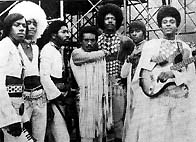 After
the commercial failure of the "Do You See What I See"
LP in 1973, guitarist Vernon Burch opted for a solo career and was replaced
by Philadelphia-native Lloyd Smith. Like the previous
album, "Coldblooded" (1974), it was a superb
set, but failed to sell the quantities the Bar-Kays and producer Allen
Jones had hoped for. Both records can be described as concept-albums,
dealing with social and political issues of the day where Sly Stone's
influence on the band is obvious. Three singles were released between
1973-1974 but none charted. The story of Stax came to an end when the
label met its demise in 1975, but for the Bar-Kays it marked a new beginning. After
the commercial failure of the "Do You See What I See"
LP in 1973, guitarist Vernon Burch opted for a solo career and was replaced
by Philadelphia-native Lloyd Smith. Like the previous
album, "Coldblooded" (1974), it was a superb
set, but failed to sell the quantities the Bar-Kays and producer Allen
Jones had hoped for. Both records can be described as concept-albums,
dealing with social and political issues of the day where Sly Stone's
influence on the band is obvious. Three singles were released between
1973-1974 but none charted. The story of Stax came to an end when the
label met its demise in 1975, but for the Bar-Kays it marked a new beginning.
By the time they signed a contract with
Mercury, the Bar-Kays' line-up had stabilized and would remain the same (with two
additions) until the mid-eighties:
James "Knuck" Alexander (bass, vocals), Charles
"Scoop" Allen (trumpet, vocals), Larry "The Eye"
Dodson (lead vocals), Harvey "Joe" Henderson (tenor
sax), Lloyd "Lucious Lloyd" Smith (guitar), Winston
"Winnie" Stewart (keyboards), Frank "Capt. Disaster"
Thompson (trombone) and Michael "Buckboard" Beard
(drums).
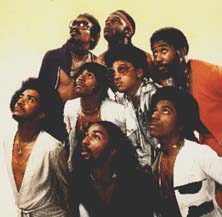 The
Bar-Kays' Mercury-debut, "Too Hot To Stop,"
(1976) was the first in a string of successful records and the group
virtually skyrocketed after opening for Parliament on the "P-Funk
Earth Tour" between 1976-77. Unlike during the Stax-period, where
the majority of the material had been supplied by Allen Jones and various
staff-writers, the Bar-Kays were by now accomplished songwriters and
penned every track on the sophomore set, "Flying High On
Your Love" (1978). It sold more than half a million copies
and presented the band with their first gold album. This led Fantasy
Records, the company which had bought the mastertapes from Stax at its
bankruptcy, to dig deep in their vaults. Fantasy took some of the rejected
and unreleased material the Bar-Kays had been working on before Stax
folded and issued it as the "Money Talks"
LP. "Holy Ghost" was lifted as a single and
shot to number nine on the R&B charts in late '78. Although Fantasy
capitalized on the fact that the Bar-Kays were one of the hottest bands
around and refused to share any of the money the record generated, "Holy
Ghost" gave the Bar-Kays a major hit and to this day it remains
one of their most requested songs on live gigs. The
Bar-Kays' Mercury-debut, "Too Hot To Stop,"
(1976) was the first in a string of successful records and the group
virtually skyrocketed after opening for Parliament on the "P-Funk
Earth Tour" between 1976-77. Unlike during the Stax-period, where
the majority of the material had been supplied by Allen Jones and various
staff-writers, the Bar-Kays were by now accomplished songwriters and
penned every track on the sophomore set, "Flying High On
Your Love" (1978). It sold more than half a million copies
and presented the band with their first gold album. This led Fantasy
Records, the company which had bought the mastertapes from Stax at its
bankruptcy, to dig deep in their vaults. Fantasy took some of the rejected
and unreleased material the Bar-Kays had been working on before Stax
folded and issued it as the "Money Talks"
LP. "Holy Ghost" was lifted as a single and
shot to number nine on the R&B charts in late '78. Although Fantasy
capitalized on the fact that the Bar-Kays were one of the hottest bands
around and refused to share any of the money the record generated, "Holy
Ghost" gave the Bar-Kays a major hit and to this day it remains
one of their most requested songs on live gigs.
After "Flying High On Your
Love," Sherman Guy (percussion/vocals) and Mark Bynum
(keyboards) came on board and made the Bar-Kays a ten men strong outfit. Known to tour
more than Mercury thought was necessary for promotional purposes and for taking a long
time to record, the Bar-Kays were ordered off the road and back in the studio. The task
was to come up with an album to compete with "Money Talks." When the
rush-recording "Light Of Life" was issued, it was the third
Bar-Kays' LP to hit the market in 1978. Although it failed in selling the kind of volumes
the band by now were accustomed to, it spawned "Shine" which rose to #14 on the
R&B singles charts in early 1979. This would be the only time in the Bar-Kays' history
where they had more than one record out in a year.
The vinyl overflow in 1978 could easily
have saturated the market, but the Bar-Kays' next LP "Injoy"
(1979) went gold and the single, "Move Your Boogie Body" peaked
at #3 on the R&B charts. Compared to its predecessors, "As One,"
was a rather mellow, even spiritual affair, but the single "Boogie Body
Land" filled every dancefloor in 1980. A year later, the Bar-Kays returned
to their street-funky roots with "Nightcruising," their third
gold seller, which contained the hit singles "Hit And Run" and "Freaky
Behavior".
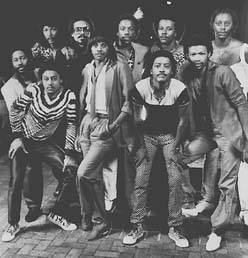 Not
only is "Nightcruising" the most consistent
and possibly the best album the Bar-Kays' cut in the eighties, but perfectly
illustrates just how they managed to score 23 times (!) on the R&B
singles chart between 1976 and 1987. While listening to "Freaky
Behavior" on the radio in 1981, you probably noticed those guitar
riffs Prince had just introduced and dug the new-wave punk-funk influence
you associated with Rick James. Yet, even if the DJ didn't announce
the record, you instantly knew that this was the new Bar-Kays' jam. Not
only is "Nightcruising" the most consistent
and possibly the best album the Bar-Kays' cut in the eighties, but perfectly
illustrates just how they managed to score 23 times (!) on the R&B
singles chart between 1976 and 1987. While listening to "Freaky
Behavior" on the radio in 1981, you probably noticed those guitar
riffs Prince had just introduced and dug the new-wave punk-funk influence
you associated with Rick James. Yet, even if the DJ didn't announce
the record, you instantly knew that this was the new Bar-Kays' jam.
Their secret weapon? Adaptability without plagiarizing. Like few groups before or after
them, the Bar-Kays perfected the art of tapping in on the current trends. They were always
in tune with what was happening on the streets, in the clubs and on the radio, at the same
time making sure they sustained their own, strong identity.
"Nightcruising" was
followed by "Propositions" (1982). "Do It (Let Me
See You Shake)" was a monster and blasted off to #9 on the R&B charts.
The follow-up forced the prudish to turn off their radios, but the sexy moans from an
unidentified woman, climaxing in the break-down of "She Talks To Me With Her
Body," surely wasn't the only reason why the single shot to #13. Later, the
album went gold.
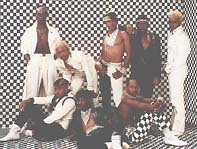 In
1983, Sherman Guy (percussion/vocals) and Charles Allen (trumpet) left
the band. With "Dangerous" (1984) came a
brand new image and what's more important, supplied the Bar-Kays with
their biggest single to date, the platinum selling "Freakshow
On The Dancefloor." It was included on the soundtrack
to the "Breakdance'" movie). "Freakshow" borrowed
quite substantially from Midnight Star's smash "No Parking On The
Dancefloor" and the follow-up "Dirty Dancer"
(R&B #17) took a few tricks from Michael Jackson's "Billie
Jean". The Bar-Kays had never come closer to copying before and
never did again either. The third single landed at R&B #12 and was
unquestionably built on an original idea. Those who had enjoyed the
cheeky "She Talks To Me With Her Body" got their fill from
"Sex-O-Matic." In
1983, Sherman Guy (percussion/vocals) and Charles Allen (trumpet) left
the band. With "Dangerous" (1984) came a
brand new image and what's more important, supplied the Bar-Kays with
their biggest single to date, the platinum selling "Freakshow
On The Dancefloor." It was included on the soundtrack
to the "Breakdance'" movie). "Freakshow" borrowed
quite substantially from Midnight Star's smash "No Parking On The
Dancefloor" and the follow-up "Dirty Dancer"
(R&B #17) took a few tricks from Michael Jackson's "Billie
Jean". The Bar-Kays had never come closer to copying before and
never did again either. The third single landed at R&B #12 and was
unquestionably built on an original idea. Those who had enjoyed the
cheeky "She Talks To Me With Her Body" got their fill from
"Sex-O-Matic."
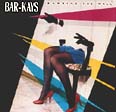 Peaking
at #12 on the R&B singles charts in the first months of 1985, "Your
Place Of Mine" was lifted from "Banging The
Wall", the Bar-Kays' first real commercial failure in
many years. The title track provided the second forty-five and struggled
to a disappointing #67 at the end of '85. From here, the group began
to deteriorate, a sad fact, which can be attributed to a number of things.
First, the climate in the industry was changing. Self-contained units
were out of fashion, as new technology enabled one person to do what
it had taken ten to perform previously. Secondly, the then newly installed
executives at Mercury were not interested in Con Funk Shun, the Bar-Kays
or any of the other veteran bands on their roster, but wanted "fresh
meat." No wonder various members of the Bar-Kays were getting tired,
restless and wanted to try their own wings. Peaking
at #12 on the R&B singles charts in the first months of 1985, "Your
Place Of Mine" was lifted from "Banging The
Wall", the Bar-Kays' first real commercial failure in
many years. The title track provided the second forty-five and struggled
to a disappointing #67 at the end of '85. From here, the group began
to deteriorate, a sad fact, which can be attributed to a number of things.
First, the climate in the industry was changing. Self-contained units
were out of fashion, as new technology enabled one person to do what
it had taken ten to perform previously. Secondly, the then newly installed
executives at Mercury were not interested in Con Funk Shun, the Bar-Kays
or any of the other veteran bands on their roster, but wanted "fresh
meat." No wonder various members of the Bar-Kays were getting tired,
restless and wanted to try their own wings.
But perhaps the most important
contributing factor to the dismantling of the group was the loss of Allen A. Jones, who
died from a heart attack on May 5, 1987. Since the early days at Stax, Allen had been
involved in practically all aspects of the band: From producing just about every record
the Bar-Kays ever did, to designing their outfits. Allen was much more than simply the
Bar-Kays' producer and manager. In fact, the Bar-Kays often referred to him as "a
member of the band" and "the glue that kept everything together".
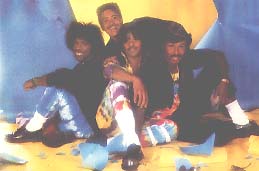 On
"Contagious," (1987) the Bar-Kays was reduced
to lead vocalist Larry Dodson, saxophonistHarvey Henderson and keyboardist
Winston Stewart. Although no longer a formal member of the band, guitarist
Lloyd Smith contributed to the LP and was depicted on the sleeve. Frank
Thompson (trombone) and Mark Bynum (keyboards) were listed as "friends."
A majority of the tracks had been produced by Allen Jones, prior to
his passing, but the two singles: "Certified True"
and "Don't Hang Up" were the results
of sessions held in Detroit with producer R.J. "the Wiz" (Ralph
James Rice) from recording group R.J.'s Latest Arrival. After the failure
with "Banging The Wall" in 1985, "Certified True"
shot to #9 on the R&B charts and proved to all non-believers that
the Bar-Kays still was a group to be reckoned with."Animal"
came out in 1989 and was the last album the Bar-Kays' released before
their contract with Mercury expired. The title track and "Struck
By You" were picked as singles, but arguably the most
interesting song was "Just Like A Teeter-Totter," which was
co-written and co-produced by Sly Stone and James Mtume. Although without
a record deal, the Bar-Kays: Harvey Henderson, Larry Dodson and Winston
Stewart were busy on the live circuit. But the times were hard for veteran
bands before the whole "old-school revival" happened in the
States and in 1993 Harvey Henderson gave his notice and Winston Stewart
followed suit shortly thereafter. On
"Contagious," (1987) the Bar-Kays was reduced
to lead vocalist Larry Dodson, saxophonistHarvey Henderson and keyboardist
Winston Stewart. Although no longer a formal member of the band, guitarist
Lloyd Smith contributed to the LP and was depicted on the sleeve. Frank
Thompson (trombone) and Mark Bynum (keyboards) were listed as "friends."
A majority of the tracks had been produced by Allen Jones, prior to
his passing, but the two singles: "Certified True"
and "Don't Hang Up" were the results
of sessions held in Detroit with producer R.J. "the Wiz" (Ralph
James Rice) from recording group R.J.'s Latest Arrival. After the failure
with "Banging The Wall" in 1985, "Certified True"
shot to #9 on the R&B charts and proved to all non-believers that
the Bar-Kays still was a group to be reckoned with."Animal"
came out in 1989 and was the last album the Bar-Kays' released before
their contract with Mercury expired. The title track and "Struck
By You" were picked as singles, but arguably the most
interesting song was "Just Like A Teeter-Totter," which was
co-written and co-produced by Sly Stone and James Mtume. Although without
a record deal, the Bar-Kays: Harvey Henderson, Larry Dodson and Winston
Stewart were busy on the live circuit. But the times were hard for veteran
bands before the whole "old-school revival" happened in the
States and in 1993 Harvey Henderson gave his notice and Winston Stewart
followed suit shortly thereafter.
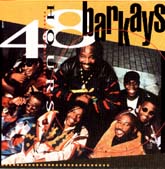 After a period of silence,
Larry Dodson re-united with bassist James Alexander and together with some new recruits,
released a single entitled "Put A Little Nasty On It" on Zoo
Records, before switching to Basix, a Memphis based independent label for the "48
Hours" CD in 1994. The singles, "Slide" and "Bar-Kays
Mega Mix" may not have catapulted them back to the upper regions of the
charts, but surely gained the band new audiences and was warmly greeted by their old fans
too. After a period of silence,
Larry Dodson re-united with bassist James Alexander and together with some new recruits,
released a single entitled "Put A Little Nasty On It" on Zoo
Records, before switching to Basix, a Memphis based independent label for the "48
Hours" CD in 1994. The singles, "Slide" and "Bar-Kays
Mega Mix" may not have catapulted them back to the upper regions of the
charts, but surely gained the band new audiences and was warmly greeted by their old fans
too.
It's been over thirty years since a
group of young, aspiring musicians from Memphis passed a sign that read "Barclay
rum" and thought it would make a good name for their band. Some 18 albums and 40
singles later, the Bar-Kays could retire, assured that their three-decades long service in
the recording industry has guaranteed them a place in music history. But make no mistake,
the Bar-Kays have no such plans. In 1996, the Bar-Kays signed to Curb Records where they
in October that year released a single entitled "Everybody Wants That
Love" and an album called "Best of Bar-Kays."
Sources & Notes:
For this bio I gathered data from various sources, but except where the source is
specifically stated, the information presented is based on my own research and interviews
with Bar-Kays' members Harvey Henderson and Larry Dodson. All chart positions referred to
are from Billboard Magazine and were compiled from Joel Whitburn's book "Top Ten R
& B Singles 1942-1988," published by Record Research, Inc.. |

 The Bar-Kays were
formed in Memphis, Tennessee sometime in the mid-sixties and originally consisted of James
Alexander (bass), Ronnie Caldwell (organ), Ben Cauley
(trumpet), Phalon Jones (sax), Carl Cunningham (drums)
and Jimmy King (guitar). In early '67, they were signed to Volt, a Stax
subsidiary. Al Jackson, the drummer with Booker T & the MGs, took a special interest
in the Bar-Kays from the start and groomed them into a funky, instrumental R&B combo
in the Mar-Keys' mold. Soon thereafter, the Bar-Kays became Stax' second house band,
supporting Sam & Dave, Otis Redding and many other of the label's premier artists. The
Bar-Kays' first single in their own right, "Soul Finger,"
became a huge hit on both the R&B and pop charts in the spring of '67 and an album
with the same title was issued as well. That summer, Otis Redding chose the Bar-Kays to be
his regular backing band and it was on route to a gig on December 10, 1967 that tragedy
struck. The plane, carrying Otis and the Bar-Kays, crashed into the frozen lake Monono,
near Madison, Wisconsin. Everyone on board was killed except trumpeter Ben Cauley, who
miraculously survived and bassist James Alexander, who had not been on the plane.
The Bar-Kays were
formed in Memphis, Tennessee sometime in the mid-sixties and originally consisted of James
Alexander (bass), Ronnie Caldwell (organ), Ben Cauley
(trumpet), Phalon Jones (sax), Carl Cunningham (drums)
and Jimmy King (guitar). In early '67, they were signed to Volt, a Stax
subsidiary. Al Jackson, the drummer with Booker T & the MGs, took a special interest
in the Bar-Kays from the start and groomed them into a funky, instrumental R&B combo
in the Mar-Keys' mold. Soon thereafter, the Bar-Kays became Stax' second house band,
supporting Sam & Dave, Otis Redding and many other of the label's premier artists. The
Bar-Kays' first single in their own right, "Soul Finger,"
became a huge hit on both the R&B and pop charts in the spring of '67 and an album
with the same title was issued as well. That summer, Otis Redding chose the Bar-Kays to be
his regular backing band and it was on route to a gig on December 10, 1967 that tragedy
struck. The plane, carrying Otis and the Bar-Kays, crashed into the frozen lake Monono,
near Madison, Wisconsin. Everyone on board was killed except trumpeter Ben Cauley, who
miraculously survived and bassist James Alexander, who had not been on the plane. In
1968, James Alexander and Ben Cauley, together with Allen Jones
(the Stax writer and producer who would continue to work with the Bar-Kays
until his untimely death in the late eighties) reformed the group and
recruited Harvey Henderson (sax), Ronnie Gordon
(keyboards), Michael Toles (guitar) and drummers
Willie Hall and Roy Cunningham. Once again,
the Bar-Kays, particularly the rhythm section but also the horns, served
as Stax' house band and backed countless artists, such as Rufus Thomas,
Albert King and The Staple Singers. The solid, bluesy funk rhythms on
Isaac Hayes' ground-breaking, platinum selling LP "Hot Buttered
Soul" were supplied by the Bar-Kays too. Although their own singles
and the "Gotta Groove" LP, issued in 1969,
sounded much like a continuation from where the first edition of the
band had left off, the post-crash Bar-Kays seemed unable to come up
with a major hit a la "Soul Finger."
In
1968, James Alexander and Ben Cauley, together with Allen Jones
(the Stax writer and producer who would continue to work with the Bar-Kays
until his untimely death in the late eighties) reformed the group and
recruited Harvey Henderson (sax), Ronnie Gordon
(keyboards), Michael Toles (guitar) and drummers
Willie Hall and Roy Cunningham. Once again,
the Bar-Kays, particularly the rhythm section but also the horns, served
as Stax' house band and backed countless artists, such as Rufus Thomas,
Albert King and The Staple Singers. The solid, bluesy funk rhythms on
Isaac Hayes' ground-breaking, platinum selling LP "Hot Buttered
Soul" were supplied by the Bar-Kays too. Although their own singles
and the "Gotta Groove" LP, issued in 1969,
sounded much like a continuation from where the first edition of the
band had left off, the post-crash Bar-Kays seemed unable to come up
with a major hit a la "Soul Finger." By 1970 drummer Roy
Cunningham had left the band and so had keyboardist Ronnie Gordon. The latter was replaced
by Winston Stewart. Under the guidance of manager/producer Allen Jones and with the
addition of the band's first lead vocalist Larry Dodson, The Bar-Kays
underwent an important transformation: from the small R&B combo they had begun their
careers as, to a self-contained band. Complete with a radically new image to fit the
musical direction, the Bar-Kays joined Sly & the Family Stone, Norman Whitfield and
Funkadelic in their experiments with fusing rock, funk and R&B and released the "Black
Rock" LP. Due to lack of support from Stax, the album went nowhere, but
modern "black rock" bands like Living Color has acknowledged that the Bar-Kays'
pioneering work had a great impact on their sound.
By 1970 drummer Roy
Cunningham had left the band and so had keyboardist Ronnie Gordon. The latter was replaced
by Winston Stewart. Under the guidance of manager/producer Allen Jones and with the
addition of the band's first lead vocalist Larry Dodson, The Bar-Kays
underwent an important transformation: from the small R&B combo they had begun their
careers as, to a self-contained band. Complete with a radically new image to fit the
musical direction, the Bar-Kays joined Sly & the Family Stone, Norman Whitfield and
Funkadelic in their experiments with fusing rock, funk and R&B and released the "Black
Rock" LP. Due to lack of support from Stax, the album went nowhere, but
modern "black rock" bands like Living Color has acknowledged that the Bar-Kays'
pioneering work had a great impact on their sound. After
the commercial failure of the "Do You See What I See"
LP in 1973, guitarist Vernon Burch opted for a solo career and was replaced
by Philadelphia-native Lloyd Smith. Like the previous
album, "Coldblooded" (1974), it was a superb
set, but failed to sell the quantities the Bar-Kays and producer Allen
Jones had hoped for. Both records can be described as concept-albums,
dealing with social and political issues of the day where Sly Stone's
influence on the band is obvious. Three singles were released between
1973-1974 but none charted. The story of Stax came to an end when the
label met its demise in 1975, but for the Bar-Kays it marked a new beginning.
After
the commercial failure of the "Do You See What I See"
LP in 1973, guitarist Vernon Burch opted for a solo career and was replaced
by Philadelphia-native Lloyd Smith. Like the previous
album, "Coldblooded" (1974), it was a superb
set, but failed to sell the quantities the Bar-Kays and producer Allen
Jones had hoped for. Both records can be described as concept-albums,
dealing with social and political issues of the day where Sly Stone's
influence on the band is obvious. Three singles were released between
1973-1974 but none charted. The story of Stax came to an end when the
label met its demise in 1975, but for the Bar-Kays it marked a new beginning. The
Bar-Kays' Mercury-debut, "Too Hot To Stop,"
(1976) was the first in a string of successful records and the group
virtually skyrocketed after opening for Parliament on the "P-Funk
Earth Tour" between 1976-77. Unlike during the Stax-period, where
the majority of the material had been supplied by Allen Jones and various
staff-writers, the Bar-Kays were by now accomplished songwriters and
penned every track on the sophomore set, "Flying High On
Your Love" (1978). It sold more than half a million copies
and presented the band with their first gold album. This led Fantasy
Records, the company which had bought the mastertapes from Stax at its
bankruptcy, to dig deep in their vaults. Fantasy took some of the rejected
and unreleased material the Bar-Kays had been working on before Stax
folded and issued it as the "Money Talks"
LP. "Holy Ghost" was lifted as a single and
shot to number nine on the R&B charts in late '78. Although Fantasy
capitalized on the fact that the Bar-Kays were one of the hottest bands
around and refused to share any of the money the record generated, "Holy
Ghost" gave the Bar-Kays a major hit and to this day it remains
one of their most requested songs on live gigs.
The
Bar-Kays' Mercury-debut, "Too Hot To Stop,"
(1976) was the first in a string of successful records and the group
virtually skyrocketed after opening for Parliament on the "P-Funk
Earth Tour" between 1976-77. Unlike during the Stax-period, where
the majority of the material had been supplied by Allen Jones and various
staff-writers, the Bar-Kays were by now accomplished songwriters and
penned every track on the sophomore set, "Flying High On
Your Love" (1978). It sold more than half a million copies
and presented the band with their first gold album. This led Fantasy
Records, the company which had bought the mastertapes from Stax at its
bankruptcy, to dig deep in their vaults. Fantasy took some of the rejected
and unreleased material the Bar-Kays had been working on before Stax
folded and issued it as the "Money Talks"
LP. "Holy Ghost" was lifted as a single and
shot to number nine on the R&B charts in late '78. Although Fantasy
capitalized on the fact that the Bar-Kays were one of the hottest bands
around and refused to share any of the money the record generated, "Holy
Ghost" gave the Bar-Kays a major hit and to this day it remains
one of their most requested songs on live gigs. Not
only is "Nightcruising" the most consistent
and possibly the best album the Bar-Kays' cut in the eighties, but perfectly
illustrates just how they managed to score 23 times (!) on the R&B
singles chart between 1976 and 1987. While listening to "Freaky
Behavior" on the radio in 1981, you probably noticed those guitar
riffs Prince had just introduced and dug the new-wave punk-funk influence
you associated with Rick James. Yet, even if the DJ didn't announce
the record, you instantly knew that this was the new Bar-Kays' jam.
Not
only is "Nightcruising" the most consistent
and possibly the best album the Bar-Kays' cut in the eighties, but perfectly
illustrates just how they managed to score 23 times (!) on the R&B
singles chart between 1976 and 1987. While listening to "Freaky
Behavior" on the radio in 1981, you probably noticed those guitar
riffs Prince had just introduced and dug the new-wave punk-funk influence
you associated with Rick James. Yet, even if the DJ didn't announce
the record, you instantly knew that this was the new Bar-Kays' jam. In
1983, Sherman Guy (percussion/vocals) and Charles Allen (trumpet) left
the band. With "Dangerous" (1984) came a
brand new image and what's more important, supplied the Bar-Kays with
their biggest single to date, the platinum selling "Freakshow
On The Dancefloor." It was included on the soundtrack
to the "Breakdance'" movie). "Freakshow" borrowed
quite substantially from Midnight Star's smash "No Parking On The
Dancefloor" and the follow-up "Dirty Dancer"
(R&B #17) took a few tricks from Michael Jackson's "Billie
Jean". The Bar-Kays had never come closer to copying before and
never did again either. The third single landed at R&B #12 and was
unquestionably built on an original idea. Those who had enjoyed the
cheeky "She Talks To Me With Her Body" got their fill from
"Sex-O-Matic."
In
1983, Sherman Guy (percussion/vocals) and Charles Allen (trumpet) left
the band. With "Dangerous" (1984) came a
brand new image and what's more important, supplied the Bar-Kays with
their biggest single to date, the platinum selling "Freakshow
On The Dancefloor." It was included on the soundtrack
to the "Breakdance'" movie). "Freakshow" borrowed
quite substantially from Midnight Star's smash "No Parking On The
Dancefloor" and the follow-up "Dirty Dancer"
(R&B #17) took a few tricks from Michael Jackson's "Billie
Jean". The Bar-Kays had never come closer to copying before and
never did again either. The third single landed at R&B #12 and was
unquestionably built on an original idea. Those who had enjoyed the
cheeky "She Talks To Me With Her Body" got their fill from
"Sex-O-Matic."  Peaking
at #12 on the R&B singles charts in the first months of 1985, "Your
Place Of Mine" was lifted from "Banging The
Wall", the Bar-Kays' first real commercial failure in
many years. The title track provided the second forty-five and struggled
to a disappointing #67 at the end of '85. From here, the group began
to deteriorate, a sad fact, which can be attributed to a number of things.
First, the climate in the industry was changing. Self-contained units
were out of fashion, as new technology enabled one person to do what
it had taken ten to perform previously. Secondly, the then newly installed
executives at Mercury were not interested in Con Funk Shun, the Bar-Kays
or any of the other veteran bands on their roster, but wanted "fresh
meat." No wonder various members of the Bar-Kays were getting tired,
restless and wanted to try their own wings.
Peaking
at #12 on the R&B singles charts in the first months of 1985, "Your
Place Of Mine" was lifted from "Banging The
Wall", the Bar-Kays' first real commercial failure in
many years. The title track provided the second forty-five and struggled
to a disappointing #67 at the end of '85. From here, the group began
to deteriorate, a sad fact, which can be attributed to a number of things.
First, the climate in the industry was changing. Self-contained units
were out of fashion, as new technology enabled one person to do what
it had taken ten to perform previously. Secondly, the then newly installed
executives at Mercury were not interested in Con Funk Shun, the Bar-Kays
or any of the other veteran bands on their roster, but wanted "fresh
meat." No wonder various members of the Bar-Kays were getting tired,
restless and wanted to try their own wings. On
"Contagious," (1987) the Bar-Kays was reduced
to lead vocalist Larry Dodson, saxophonistHarvey Henderson and keyboardist
Winston Stewart. Although no longer a formal member of the band, guitarist
Lloyd Smith contributed to the LP and was depicted on the sleeve. Frank
Thompson (trombone) and Mark Bynum (keyboards) were listed as "friends."
A majority of the tracks had been produced by Allen Jones, prior to
his passing, but the two singles: "Certified True"
and "Don't Hang Up" were the results
of sessions held in Detroit with producer R.J. "the Wiz" (Ralph
James Rice) from recording group R.J.'s Latest Arrival. After the failure
with "Banging The Wall" in 1985, "Certified True"
shot to #9 on the R&B charts and proved to all non-believers that
the Bar-Kays still was a group to be reckoned with."Animal"
came out in 1989 and was the last album the Bar-Kays' released before
their contract with Mercury expired. The title track and "Struck
By You" were picked as singles, but arguably the most
interesting song was "Just Like A Teeter-Totter," which was
co-written and co-produced by Sly Stone and James Mtume. Although without
a record deal, the Bar-Kays: Harvey Henderson, Larry Dodson and Winston
Stewart were busy on the live circuit. But the times were hard for veteran
bands before the whole "old-school revival" happened in the
States and in 1993 Harvey Henderson gave his notice and Winston Stewart
followed suit shortly thereafter.
On
"Contagious," (1987) the Bar-Kays was reduced
to lead vocalist Larry Dodson, saxophonistHarvey Henderson and keyboardist
Winston Stewart. Although no longer a formal member of the band, guitarist
Lloyd Smith contributed to the LP and was depicted on the sleeve. Frank
Thompson (trombone) and Mark Bynum (keyboards) were listed as "friends."
A majority of the tracks had been produced by Allen Jones, prior to
his passing, but the two singles: "Certified True"
and "Don't Hang Up" were the results
of sessions held in Detroit with producer R.J. "the Wiz" (Ralph
James Rice) from recording group R.J.'s Latest Arrival. After the failure
with "Banging The Wall" in 1985, "Certified True"
shot to #9 on the R&B charts and proved to all non-believers that
the Bar-Kays still was a group to be reckoned with."Animal"
came out in 1989 and was the last album the Bar-Kays' released before
their contract with Mercury expired. The title track and "Struck
By You" were picked as singles, but arguably the most
interesting song was "Just Like A Teeter-Totter," which was
co-written and co-produced by Sly Stone and James Mtume. Although without
a record deal, the Bar-Kays: Harvey Henderson, Larry Dodson and Winston
Stewart were busy on the live circuit. But the times were hard for veteran
bands before the whole "old-school revival" happened in the
States and in 1993 Harvey Henderson gave his notice and Winston Stewart
followed suit shortly thereafter. After a period of silence,
Larry Dodson re-united with bassist James Alexander and together with some new recruits,
released a single entitled "Put A Little Nasty On It" on Zoo
Records, before switching to Basix, a Memphis based independent label for the "48
Hours" CD in 1994. The singles, "Slide" and "Bar-Kays
Mega Mix" may not have catapulted them back to the upper regions of the
charts, but surely gained the band new audiences and was warmly greeted by their old fans
too.
After a period of silence,
Larry Dodson re-united with bassist James Alexander and together with some new recruits,
released a single entitled "Put A Little Nasty On It" on Zoo
Records, before switching to Basix, a Memphis based independent label for the "48
Hours" CD in 1994. The singles, "Slide" and "Bar-Kays
Mega Mix" may not have catapulted them back to the upper regions of the
charts, but surely gained the band new audiences and was warmly greeted by their old fans
too.